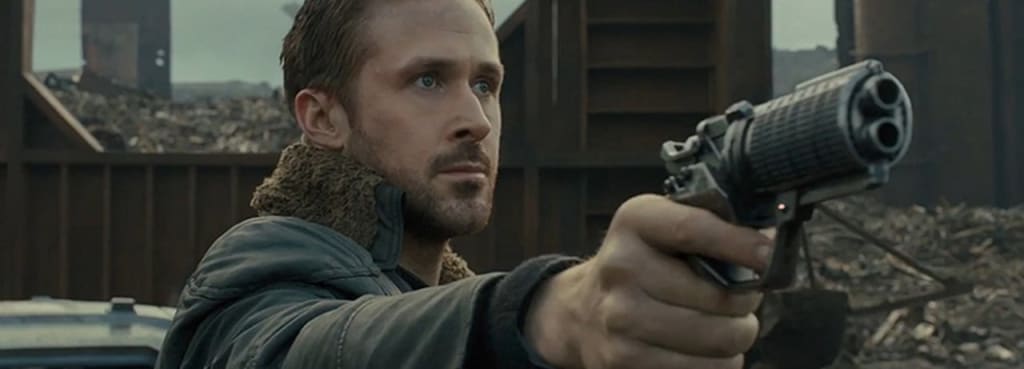Blade Runner 2049 Movie Review
This outstanding sci-fi follow-up stands as one of the best films of 2017.

Released: October 5th 2017 (UK)
Length: 163 Minutes
Certificate: 15
Director: Dennis Villeneuve
Starring: Ryan Gosling, Harrison Ford, Ana De Armas, Sylvia Hoeks, Robin Wright, Mackenzie Davies and Jared Leto
1982’s Blade Runner is an undisputed sci-fi classic and with such a powerful impact, it’s difficult to imagine anything else in the genre measuring up to it. 35 years in the making, Dennis Villenueve’s Blade Runner 2049 does an incredibly rare thing; not only match and respect the original, but arguably surpass it.
Three decades after the events of the first film and replicants, while still widely persecuted, have become a part of society but tension continues to exist both in and out of the city of Los Angeles; there are those who wish to control and those who wish to be free. As the line between human and android blurs further, the new Blade Runner Agent K (Ryan Gosling) and the LAPD find themselves attempting to contain a conspiracy that could set off the fires of conflict between the two. Keeping the same slow pacing of the first, 2049 may use a similar formula but rather than being a basic re-tread or a franchise kick-starter, its narrative is just as imaginative and ambitious as the first film. The mystery is made far more enticing here with the on-screen action often relaying events with minimal dialogue and exposition. The main themes explored in Blade Runner 2049 include control, freedom, and the nature of reality; while in the original replicants were a small minority, here they come within reaching distance of surpassing the humans that created them. Simultaneously, the human creators have grown numb to the notion of ethics, treating replicants as expendable armies and servants to increase their already strong influence and power. By venturing outside the bounds of Los Angeles, the film also greatly extends the horizons of an already stunning future world; enormous rubbish collectors spill their contents around the countryside and scavengers pour through the scrap metal that litters the surroundings.
Blade Runner 2049 makes some important steps to fix the problems of the original, beginning with a more well-rounded set of central characters. After delivering a highly nuanced performance in 2011’s Drive, Ryan Gosling is perfectly cast as Agent K; at first, he’s rather devoid of emotion, steadfastly dedicated to his task but the discoveries he makes lead him to question the places of himself and others in this grungy world. While I won’t give away the true nature of Ana De Armas’s character, the connection she shares with K is a tremendous improvement on the original film’s stilted chemistry. The same can also be said of Harrison Ford, who doesn’t take the spotlight away from Gosling yet still maintains Deckard’s gruff personality. On the other side of the coin, we have businessman Niander Wallace (Jared Leto) whose fascinating monologues deepen the already mysterious nature of android development. The other side characters such as Robin Wright’s Lt. Joshi of the LAPD and Lennie James’s odd connections with orphaned children work to broaden the world itself, drawing a contrast between the tight inner workings of the city and the unforgiving wastes beyond the walls. By placing its main characters front and centre in the plot, 2049 creates a combination that gels more organically than the original did.
2049 is every bit as mesmerising as its predecessor, but the excellent attention to detail and efforts to expand on the original environments puts it over the top. The blues of the first film’s setting are contrasted with a ferocious orange that oozes atmosphere in the film’s third act. Making use of computer generated effects, every location feels palpable and real, with the camera often slowly panning around to explore or remaining static to create a huge sense of scale. Much like the methodical pacing, the camerawork uses cuts sparingly, allowing the finer points of the story to sink in seamlessly. The same holds true for the music; this time the dynamic synths are complemented by a set of ominous drums which hammer the rising tension into the audience and soundtrack also features several intense swells that powerfully convey the revelations discovered by the characters. The spurts of action that do occur don’t last long but they feel incredibly visceral, matching the thunderous pounding of the compositions. Not content with aping the look and style of the original, the sequel builds on top of an already excellent aesthetic, creating a high standard for both modern computer effects and immersion.
Blade Runner 2049 is an awe-inspiring package of thought-provoking themes, jaw-dropping environments, and superb acting prowess; it’s the perfect sequel to the 1982 original and moreover it’s one of the best films of the year.
Rating: 5/5 Stars (Exceptional)
About the Creator
Robert Cain
I'm a well-travelled blogger and writer from the UK who is looking to spread his blogs and freelance writings further afield. You can find more of my work at https://robc25.wixsite.com/thecainagecritique.






Comments
There are no comments for this story
Be the first to respond and start the conversation.